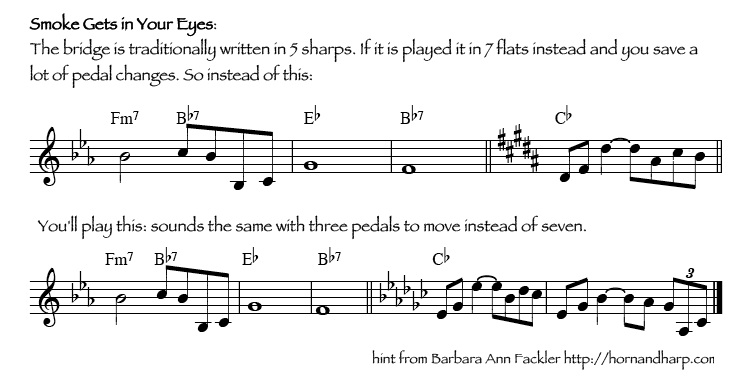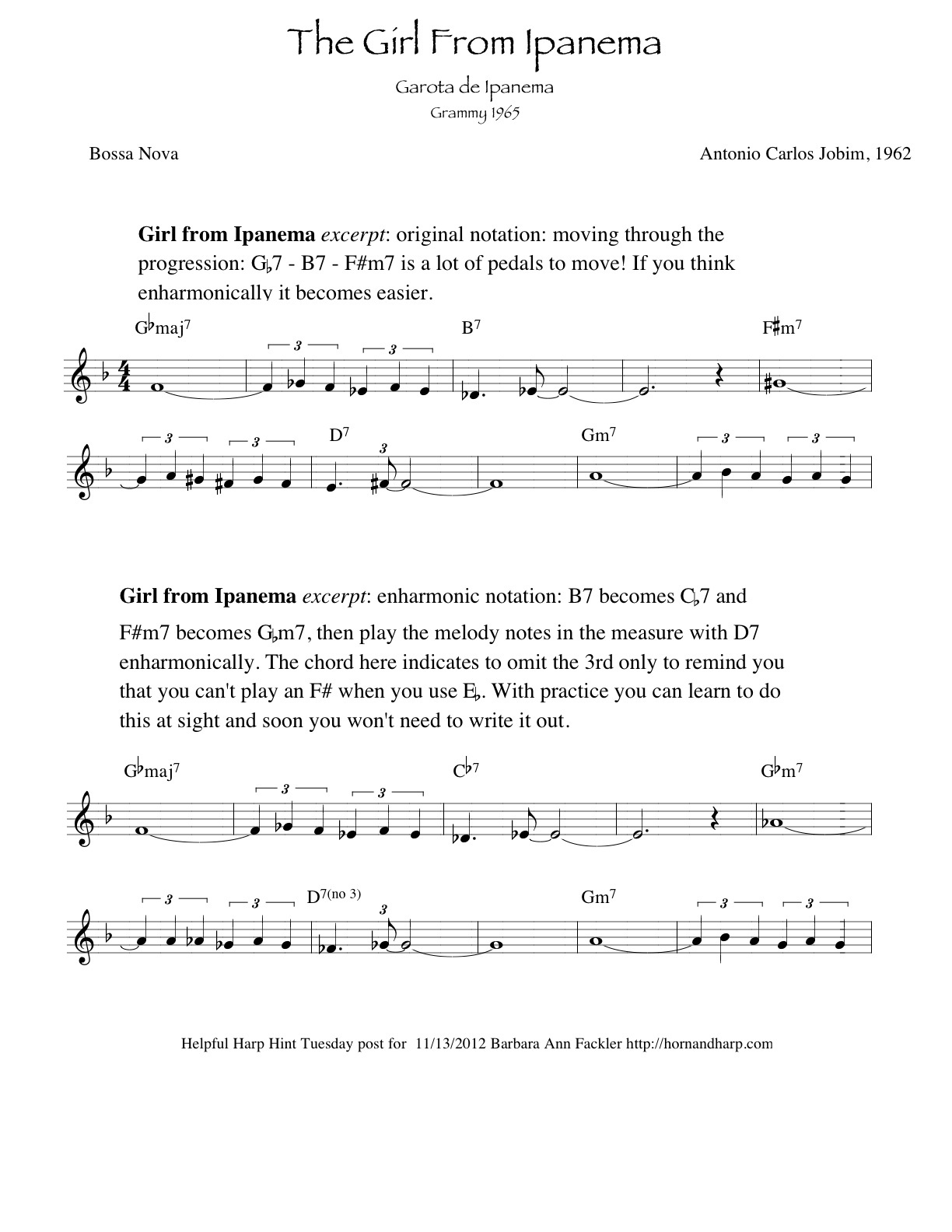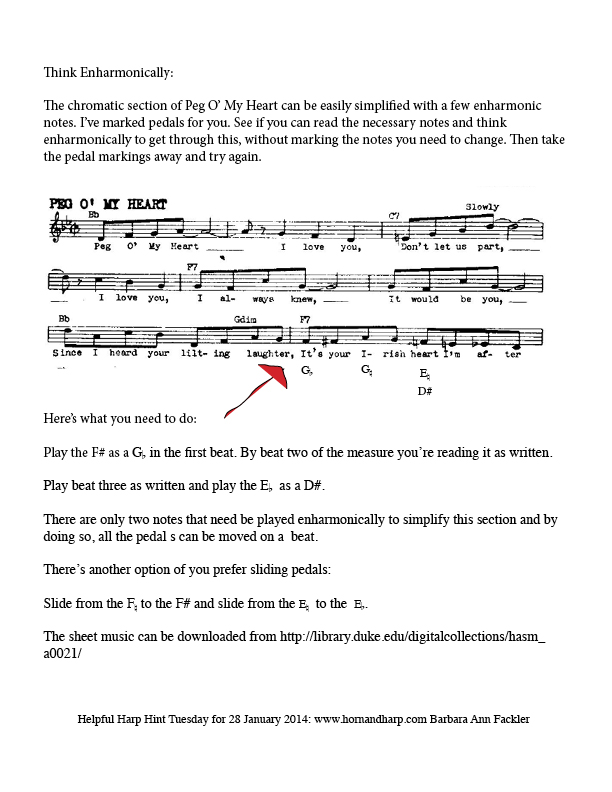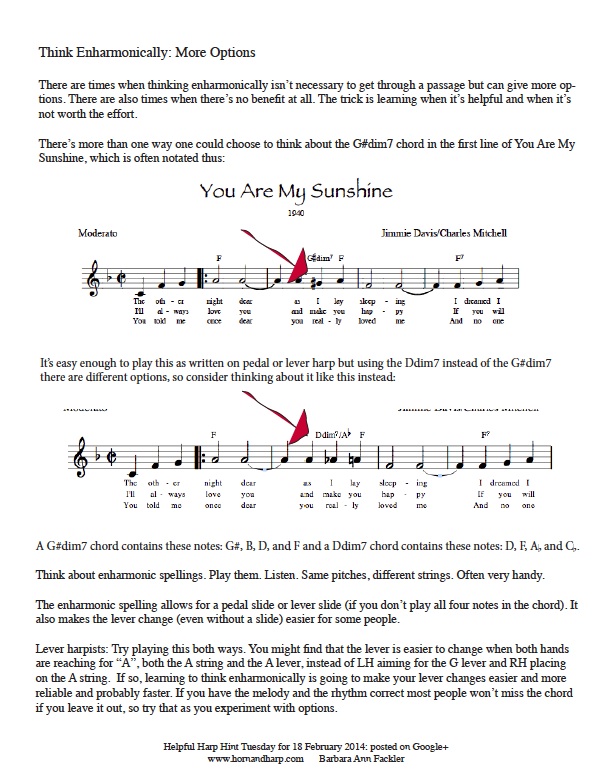Enharmonic Spelling Tricks for Harpists
by Barbara Ann Fackler
Sometimes spelling a chord, passage or just one note enharmonically simplifies execution of a passage or makes the passage possible. Orchestration books include examples of how a harpist can respell music enharmonically but few actually teach why one might want to do this. This page is not intended for composers as much as harpists who are new to the idea of enharmonic spellings.
Hint Nr. 1:
The original key change in Music of the Night goes from the key of D flat (5 flats) to the key of B (5 sharps). This isn't bad on piano but it's a lot of pedals on harp: all seven pedals must move, some more than one knotch. The easy solution? Play the B major section in C flat major instead. If you practice this enough, you'll get to where you can just transpose at sight without rewriting it. The example below shows the music in the new key. It will sound exactly the same.

Hint Nr. 2:
Because this hint includes a picture of both the original key and the more harp friendly key, it's easy to see what you'll do with your hands. When you transpose from the key of B major to C flat major, you are moving up one half step. Simply play what you see one string higher on the harp if you don't rewrite the part. When you treat this key change in this way this is possible for an advanced lever harpist.

Hint Nr. 3:
Body and Soul, a popular song from 1930 ends with this chord progression is C, C#, C, C#, C. That's three pedal changes between each chord UNLESS you get clever. If you think enharmonically, you'll play a D flat chord (D flat, F natural and A flat) instead of the C# chord (C#, E#, and G#), two pedals and different strings makes this a breeze. No need to write it out, just learn to think differently.
Also, see the E flat in the triplet? If it's played as a D# instead you simplify your pedal movements. It's easier to get to the C chord because you still have the E natural and your foot will be on the D pedal, ready for that D flat chord you'll use instead of the C# chord. You'll lose the 5th of the G7 chord, but only briefly.

Hint Nr. 4: download a PDF version of this hint
Read the full Helpful Harp Hint Tuesday post.

Hint Nr. 5: download a PDF version of this hint
Read the original Helpful Harp Hint Tuesday post.

Hint Nr. 6 Peg O' My Heart Download a PDF version.

Once you've worked through the tutorial, here's a PDF with only the music, not the tutorial notes.


Hint Nr. 8: Find the Note Without Retuning
Think Enharmonically: Find the Note Without Retuning
Most lever harpists know about the two prominent tunings: Eb and C. While each has its benefits and most harpists have a strong preference for one or the other, there’s still a compromise involved. No matter which tuning you adopt, you’ll be left without some pitches, or so it would seem at first.
Look at the G-7 chord here in the second line that moves to a G flat dim. Most problematic is the melody note. The G flat diminished chord can be omitted without too much damage to the original, but the melody note is important.
The simple solution is to play the D flat as a C#. Both common lever harp tunings include a C#. Neither one has a D flat included unless you think enharmonically.
When you see a note that’s not on your lever harp, give it second thought and see if it’s there, hiding, as an enharmonic note.
Pedal harpists aren’t off the hook for clever thinking: here’s a great place for a sliding pedal: slide from the D natural to the D flat. There’s no respelling needed and some find it easier to add the pedal slide than to return to the same string yet another time.

Hint Nr. 9: Expand Your Thinking
Thinking enharmonically can make the difference for a harpist between a piece being impossible or not. Here's an example to get you started thinking about possible options. In this old gem, melodic notes are spelled theoretically correct, a practice that is often less than practical. Note first the Gdim chord with the A# in the melody. Remember your theory training, it's the same as B flat, which is in the chord. The complication for a harpist is that the two pitches, as named, A# and Bflat are found on different strings. It's not like the black keys on piano.
Expand your repertoire by expanding your thinking. Learn to respell chords at sight. When you do, you'll find that you're able to sight read music you'd once thought impossible.

The Enharmonic Tutorials by Barbara Ann Fackler are licensed under a Creative Commons Attribution-Noncommercial-No Derivative Works 3.0 United States License.









